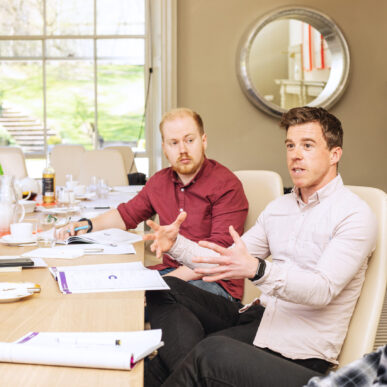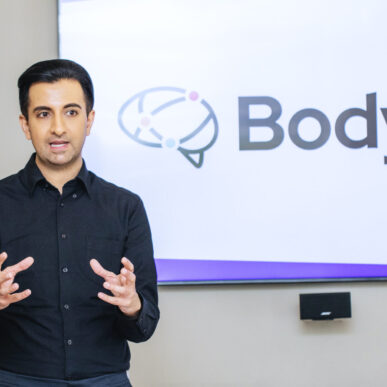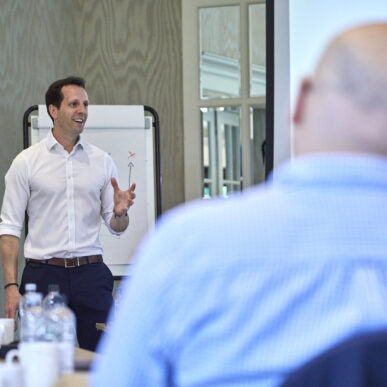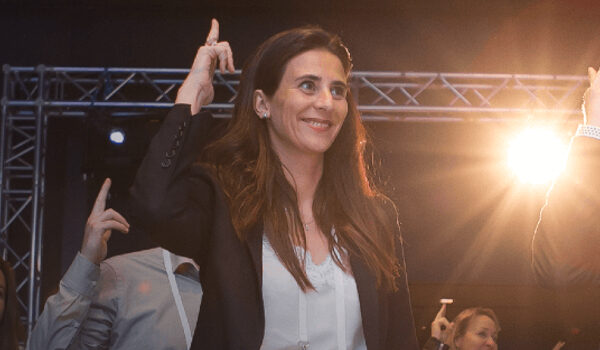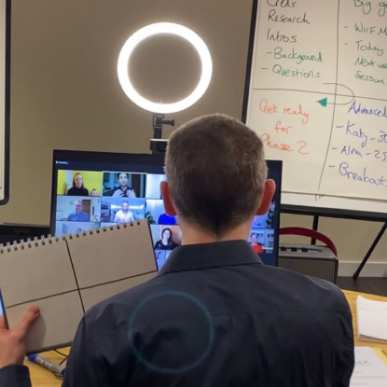Most of us cringe when we hear our own voice or see ourselves on video. We think, “Do I really sound like that?” or “Why do I move my hands so much?” But if you want to transform your presentation skills, grow your confidence, or strengthen your communication at work, recording yourself is one of the fastest ways to make progress.
There’s actually a psychological reason for this discomfort.
- With our voice: What you hear in your head is not what others hear. Inside your skull, sound vibrations travel through bone as well as air, making your voice sound richer and lower. On a recording, you hear only the air-conducted version, higher, thinner, less “you.” Psychologists call this the voice confrontation effect, the uneasy reaction we get when hearing our own playback. Research shows we consistently rate our voice more negatively than others do. What sounds “awkward” to you often comes across as clear, warm, or confident to everyone else.
- With video: The discomfort is similar to seeing yourself in a candid photo you didn’t pose for. Psychologists link this to the mere-exposure effect; we prefer what’s familiar. Because we’re used to seeing our face in the mirror (a reversed image), video shows us a version that feels subtly “off.” Add to that every small habit you weren’t aware of – blinking, fidgeting, hand movements – and playback can feel like a magnifying glass on your quirks.
- With mindset: It can trigger self-criticism. Our brain has a natural negativity bias, described by psychologist Rick Hanson as “like Velcro for bad experiences and Teflon for good ones.” We repel the positives quickly, “my voice carried well” or “I looked confident”, while letting the negatives stick.
I know this first-hand. I’ve worked in broadcasting since 2001, and it took me years to feel comfortable watching or listening back to recordings of myself. At first, all I could hear were the things I wanted to change. But I also knew it was one of the most powerful tools for improvement. Over time, I realised the trick was to balance it: notice what I was doing well as much as what I could improve, and not be too hard on myself in the process. That clash between how we think we come across and the reality on screen is what makes playback uncomfortable. But leaning into that discomfort is where real growth happens.
Why Recording Works
Actors, broadcasters, musicians constantly review themselves. They know you can’t fix what you can’t see (or hear). The same applies in business.
When you record yourself, you shine a light on habits that slip under the radar in the moment. Talking too fast, filler words creeping in, or speaking with less energy than you thought. These things matter because:
- In a presentation, pace and clarity can be the difference between people remembering your key point or forgetting it five minutes later.
- In a meeting, tone and body language influence whether colleagues lean in or mentally switch off.
- In a pitch or client conversation, your presence shapes how much trust and confidence you inspire.
By recording and reviewing yourself, you’re not guessing how you came across. You’re seeing the real impact of your communication, the version your audience actually experiences. That awareness gives you the chance to adjust, refine, and make sure your words truly land.
Start Simple: Voice Notes & Video
You don’t need a production studio to transform your presentation skills. A phone and a few minutes of playback can reveal more than you expect.
Voice Notes
Open the Voice Note app and record a short update. When you listen back, pay attention to three things:
- Speed: Are you racing through sentences? If so, practise pausing after key points. A pause gives your audience time to absorb your message and makes you sound more confident.
- Pitch: Do you speak in a monotone? Try adding light and shade. Emphasise keywords by raising or lowering your pitch slightly, as if you’re underlining the most important part of the sentence.
- Volume: Does your voice carry? Projection isn’t about shouting; it’s about energy. Imagine speaking to the person at the back of the room rather than the one right in front of you.
Even a 30-second voice note can highlight patterns you don’t notice in the moment.
Video
Prop your phone up and record yourself giving a short talk. When you watch it back, ask yourself:
- Movement: Are you pacing nervously, or standing frozen? Aim for purposeful movement, taking a step to emphasise a transition, not wandering.
- Gestures: Are your hands hidden, fidgeting, or overactive? Gestures should live in the “power zone”, roughly between your waist and shoulders, where they feel natural and support your words.
- Presence: Do you look engaged? Eye contact with the camera (or your audience) builds trust; looking down or away too often weakens your impact.
The goal isn’t to perform; it’s to align your sound and appearance with the message you want to convey.
Mindset: Be Your Coach, Not Your Critic
This part is vital. Many people give up on recording because they focus only on what they dislike. You spot one awkward pause or hear one flat note in your voice, and suddenly the whole recording feels like a disaster.
Instead, think like a coach. Coaches don’t just point out flaws; they highlight strengths and give specific, practical ways to improve.
Here’s how to do the same for yourself:
- Spot the wins first. Before looking for problems, identify at least one thing you like. Maybe your voice had more authority than you expected, or your smile made you approachable. Write it down; this keeps you balanced.
- Focus on one tweak at a time. Don’t try to fix everything. If you notice you spoke too quickly, focus on slowing your pace in the next recording. If your gestures felt stiff, concentrate only on loosening your hands. Improvement sticks when it’s simple and specific.
- Reframe the “flaws.” Instead of thinking “I sound nervous”, reframe it as “I need to add more pauses to sound calm.” This shifts your inner dialogue from criticism to coaching.
- Celebrate progress, not perfection. Compare today’s recording with last week’s. Did you pause more? Did you project with more confidence? Coaches measure progress in steps, not leaps.
- Treat feedback like a rehearsal, not a judgment. Imagine you’re practising a sport or an instrument. Each playback isn’t a verdict on your ability; it’s just the next repetition helping you sharpen your skills.
When you approach playback this way, the discomfort doesn’t disappear, but it becomes constructive. Instead of tearing yourself down, you’re building yourself up.
A 7-Day “Press Record” Challenge
Want to see real change? Try this:
- Each day for a week, record a 60-second talk (e.g. what you achieved today, a story from your life, or a work update).
- Listen or watch with curiosity, not judgment.
- Jot down one strength and one tweak for the future.
By the end of the week, you’ll feel more comfortable, more aware, and more in control of your presence.
Turning Awareness Into Confidence
Recording yourself isn’t about chasing perfection; it’s about creating awareness. And awareness gives you choices.
When I look back on my broadcasting career, reviewing my output on both radio and TV was one of the hardest but most valuable habits I built. It gave me the chance to spot things I never would have noticed in the moment and gradually refine how I came across. More importantly, it taught me to recognise my strengths alongside the areas to improve.
And the same applies in business. Whether you’re leading a meeting, pitching to clients, or standing on stage, your presence shapes how people respond to you. The more aware you are of how you come across, the more intentional you can be in creating impact.
When you press record, you’re not just hearing your voice or seeing yourself on screen. You’re building the skills to communicate with clarity, confidence, and credibility every time you speak.
Ready to Take the Next Step?
Recording yourself is a powerful first step, but real transformation comes from combining self-awareness with expert feedback.
At Body Talk, we help people transform their presentation skills and build lasting confidence, whether through tailored 1-to-1 coaching or our interactive Presentation Skills Training.
👉 Discover our Presentation Skills Training
👉 Find out more about our 1-to-1 coaching programmes







